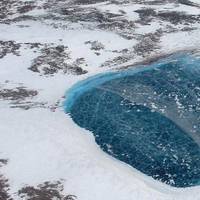Beyond the Tip of the Iceberg Tech: RDT&E's Annual Arctic Technology Evaluation

The Coast Guard Research and Development Center (RDC) teamed up with Coast Guard Cutter Campbell’s crew this summer to evaluate five technologies as part of the RDC’s annual Arctic Technology Evaluation. The Campbell crew conducted the evaluations during their two-month deployment supporting joint Arctic operations off Greenland’s western coast, returning to their Kittery, Maine, homeport on Sept. 29, 2020.“Testing various technologies by cutter crews for operation in cold and Arctic environments provides highlights on what works and what may need improvement…
Arctic Nature's Clock has Gone Haywire
Nature’s clock is running fast in the Arctic, thanks to climate change. Some plants in the low Arctic of Greenland are emerging sooner than usual. Due to diminishing sea ice cover, spring is coming sooner to some plant species in the low Arctic of Greenland, while other species are delaying their emergence amid warming winters, says a study. "The timing of seasonal events, such as first spring growth, flower bud formation and blooming, make up a plant’s phenology — the window of time it has to grow, produce offspring and express its life history. Think of it as “nature’s clock.” - says a study published in the journal Biology Letters and led by the University of California, Davis.
Arctic Sea Ice Sets Record Low Extent at Winter Maximum

Arctic sea ice has set a new winter record by freezing over the smallest extent since satellite records began in 1979, in a new sign of long-term climate change, U.S. data showed on Thursday. The ice floating on the Arctic Ocean around the North Pole reached its maximum annual extent of just 14.54 million square kms (5.61 million sq miles) on Feb. 25 - slightly bigger than Canada - and is now expected to shrink with a spring thaw. "This year's maximum ice extent was the lowest in the satellite record…
Crystal Cruises to Sail Elusive Northwest Passage
The “World’s Best” Crystal Cruises is introducing a new expedition-style voyage traversing the Arctic Ocean via the legendary Northwest Passage – one so mysterious and remote (500 miles north of the Arctic Circle), that explorers spent centuries seeking the passage, until it was first completed successfully by Roald Amundsen just over 100 years ago. Crystal will be the first luxury cruise line to ever navigate the route, maneuvering through 900 miles of majestic waterways lined with spectacular glaciers, towering fjords, and vast unspoiled landscapes away from mainstream civilization and tourism, north of mainland Canada. Beginning August 16, 2016 in Anchorage/Seward, Alaska, the award-winning Crystal Serenity will sail for 32 days from the Pacific to the Atlantic Ocean/New York City.
Crystal to Cruise via Arctic Northwest Passage in 2016
Crystal Cruises says it is introducing a new expedition-style voyage traversing the Arctic Ocean via the Northwest Passage (500 miles north of the Arctic Circle) that explorers spent centuries seeking, until it was first completed successfully by Roald Amundsen just over 100 years ago. Crystal claims to be the first luxury cruise line to ever navigate the route, maneuvering through 900 miles of majestic waterways lined with spectacular glaciers, towering fjords, and vast unspoiled landscapes away from mainstream civilization and tourism, north of mainland Canada. Beginning August 16, 2016 in Anchorage/Seward, Alaska, the award-winning Crystal Serenity will sail for 32 days from the Pacific to the Atlantic Ocean/New York City.
Museum Exhibition on Boatbuilding
Beginning January 28, 2000, the Peabody Essex Museum, in Salem, Mass., will present an exhibition on boat design entitled Suggestive Curves. The groundbreaking exhibition showcases the work of craftsmen from the U.S., Native America, Asia and the Pacific Islands, spanning two centuries of small watercraft design. The exhibition will run through May 7, 2000. The exhibition features 22 vessels, including a sealskin kayak built in Greenland sometime in the late 19th Century. Its Inuit designer skillfully employed what few materials he had at his disposal: sealskin tautly sewn over a frame of willow or driftwood. The lightweight craft is scarcely wider than the passenger it's designed to carry. As such, it's perfectly suited to cut through the strong winds and icy seas of the Davis Strait.
Museum Exhibition on Boatbuilding
Beginning January 28, 2000, the Peabody Essex Museum, in Salem, Mass., will present an exhibition on boat design entitled Suggestive Curves. The groundbreaking exhibition showcases the work of craftsmen from the U.S., Native America, Asia and the Pacific Islands, spanning two centuries of small watercraft design. The exhibition will run through May 7, 2000. The exhibition features 22 vessels, including a sealskin kayak built in Greenland sometime in the late 19th Century. Its Inuit designer skillfully employed what few materials he had at his disposal: sealskin tautly sewn over a frame of willow or driftwood. The lightweight craft is scarcely wider than the passenger it's designed to carry. As such, it's perfectly suited to cut through the strong winds and icy seas of the Davis Strait.
Museum Exhibition on Boatbuilding
Beginning January 28, 2000, the Peabody Essex Museum, in Salem, Mass., will present an exhibition on boat design entitled Suggestive Curves. The groundbreaking exhibition showcases the work of craftsmen from the U.S., Native America, Asia and the Pacific Islands, spanning two centuries of small watercraft design. The exhibition will run through May 7, 2000. The exhibition features 22 vessels, including a sealskin kayak built in Greenland sometime in the late 19th Century. Its Inuit designer skillfully employed what few materials he had at his disposal: sealskin tautly sewn over a frame of willow or driftwood. The lightweight craft is scarcely wider than the passenger it's designed to carry. As such, it's perfectly suited to cut through the strong winds and icy seas of the Davis Strait.





